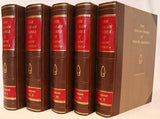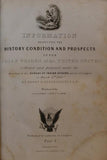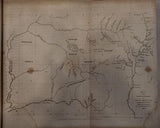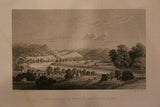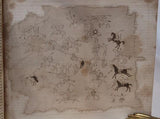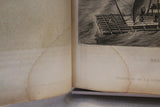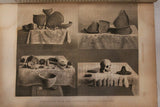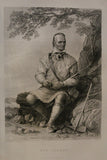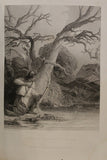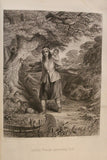Information, Respecting the History, Condition and Prospects of the Indian Tribes of the United States:Collected and Prepared Under the Direction of the Bureau of Indian Affairs, Per Act of Congress of March 3rd, 1847
Author: Henry Rowe Schoolcraft (1793-1864)
Year: 1853
Publisher: Lippincott, Grambo & Company
Place: Philadelphia
Description:
5 volumes. xiii+[13]-+568 pages with half-titles, additional engraved title-page, tables, 76 engraved plates which include scenes and views, 3 full-page maps, 17 plates of artifacts engraved in colors, and 15 with original hand-color. xxiv+[17]-608 pages with half-titles, additional engraved title-page, tables, 78 engraved plates (five folding), including view and scenes, 6 maps, 23 plates of artifacts engraved in color (some finished by hand), 5 engraved plates with original hand-color, and 2 tables of Cherokee alphabet. xviii+[19]-535 pages with half-titles, additional engraved title-page, tables, 45 engraved plates with views and scenes (3 folding), including: 4 maps, including: that Showing the location of the Indian Tribes within the United States and a Map of Oregon Showing the location of Indian Tribes, both 1852 and with original hand-color in outline, and 22 plates of artifacts engraved in color. xxvi+[19]-667 pages with half-titles, additional engraved title-page, tables, 41 engraved plates, including: 3 maps, 2 with original hand-color in outline and including a Map of the South western part of New Mexico and a Map of the Indian Colonies West of Missouri and Arkansas, both 1853, 15 plates of artifacts engraved in color (some finished by hand), and one engraving with original hand-color. xxvi+[19]-667 pages with half-titles, additional engraved title-page, tables, 41 engraved plates with views and scenes, including: 3 maps some (folding), including a Map of the South western part of New Mexico, 15 plates of artifacts engraved in color. xxiv+[25]-712 pages with 36 engraved plates (some folding), including 2 plates of artifacts engraved in color, 9 wood-cuts and appendix. Quarto (11" x 8") rebound in half leather with red label to spine in gilt lettering and four raised spine bands, over grey boards with lettering in gilt. (Howes S183c) Third edition. The first two editions were six volumes complete, this the third, was only five.
Schoolcraft joined the first American expedition through the upper Great Lakes, headed by Lewis Cass, governor of Michigan Territory. In August of 1821 he was secretary to a treaty council in Chicago for acquisition of Potawatomi and Ottawa land in southwestern Michigan. By 1822 he was employed by the federal Indian service, as the first Indian agent at Sault Ste. Marie, Michigan. In 1823 Schoolcraft married Jane Johnston, the daughter of trader John Johnston, whose wife, Oshawguscodawayqua, came from a respected Ojibwa family in LaPointe, Wisconsin. During the summer of 1831, Schoolcraft "investigated the continuing Sioux-Ojibwa boundary dispute in the Minnesota-Wisconsin district, then led the well-known expedition to the head of the Mississippi River, reported in Narrative of an Expedition through the Upper Mississippi to Itasca Lake . . . in 1832 (1834). With the closing of the Sault Ste. Marie agency in 1832, he was transferred to the agency at Mackinac Island in 1833. As commissioner representing the federal government, he secured Ottawa and Ojibwa lands in the eastern Upper Peninsula and northwestern Lower Peninsula of Michigan through terms of a treaty signed in Washington on 28 March 1836. Following this success, he was appointed superintendent of the Michigan Indian Agency in July 1836. He subsequently negotiated four treaties with Ojibwa bands for the surrender of reservation lands in southeastern Michigan. Spending winters in Detroit, he was an active member of the Michigan Historical Society, which he had established in 1828. He also served as regent of the reincorporated University of Michigan from 1837 to 1841...In 1845 Schoolcraft conducted a state-sponsored census of New York Indians that is reported in Notes on the Iroquois (1846). Expanding his ideas for enumerating Indians, he next lobbied in Washington for a bill, passed in March 1847, to conduct a national Indian census ostensibly to provide the basis for future government legislation. In 1847 he married Mary Howard, a plantation-reared South Carolinian who promoted his career but alienated his children. Employed again by the Bureau of Indian Affairs from 1847 to 1857, he brought out the six-volume Historical and Statistical Information Respecting the . . . Indian Tribes of the United States (1851-1857), a miscellany of articles and data covering selected Indian tribes and archaeological investigations.
Condition:
Rebound with new end papers. Damp stained throughout, some plates age toned, foxing in all volumes else a good set.














